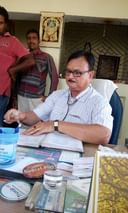Onchocerciasis: Treatment, Procedure, Cost and Side Effects
Last Updated: Jan 20, 2025
What is the treatment?
Onchocerciasis is also known as 'river blindness'.
How is the treatment done?
Onchocerciasis is a typical condition of irritation in the eye, which can further turn into redness, inflammation and in extreme cases, blindness. It is also known as ‘river blindness’ and is caused by the infection with the parasitic worm ‘onchocerca volvulus’.
This infection is the second most common reason for blindness and can be caused by the bite of a black fly. This fly can lay eggs under the skin of the eye, and spread throughout. These are most commonly found near rivers or polluted lakes.
It is more difficult to eradicate the adult flies from the body. Once inside, they can breed for about 15 years inside. Their larvae however live long enough for a timespan of 2 years. Antibiotics or drugs used to treat this disease are effective to remove the larvae from spreading. They also reduce the rashes, redness and itching in the eye and body. However, the adult flies take time to go out of the body and hence the medication needs to be taken annually for a period of about 10 or more years.
The symptoms differ from individual to individual with some people not experiencing any symptoms at all, which make it difficult for them to detect the condition.
Most of the responses incurred by the human body are towards dead or lying larvae. Sometimes these remain under the eye and other parts of the body, turning that part of the skin into a brownish appearance.They can also contribute to conditions like ‘hanging groin’ in extreme cases.
Who is eligible for the treatment? (When is the treatment done?)
Generally, onchocerciasis can be treated with the use of antibiotics or medicines like the ivermectin, a very effective medication. Ivermectin needs to be given to the patient, twice a year. This medicine helps in killing the larvae and hence any further spreading of the infection.
To kill the adult worms, a new and highly effective medicine called the ‘doxycycline’ has been revealed which kills the Wolbachia bacteria, on which the adult worms rely on, for survival.
Symptoms for loa loa also need to be checked before the treatment for onchocerciasis begins, as ivermectin can create a toxic reaction in the body if signs of loa loa are not treated prior to the new medication.
Who is not eligible for the treatment?
Anyone suffering from this condition is eligible to undergo treatment for the same. Delaying the treatment can cause permanent blindness. From children to adults, onchocerciasis can be treated if attempted to be cured.
Are there any side effects?
There are no age or health restrictions for the eligibility for onchocerciasis.
What are the post-treatment guidelines?
The medication used to treat onchocerciasis is ivermectin, and before using this, the doctor should check for loa loa in the patient as the presence of that condition may cause inflammation and spread of the infection. If loa loa is not ruled out, ivermectin can cause toxic encephalopathy in the patient instead of curing both the conditions.
How long does it take to recover?
The treatment should be carried out for years with the intake of ivermectin or similar antibiotics. Ivermectin should be taken twice annually, and should be repeated for around 10 to 12 years to completely eradicate the symptoms of river blindness.
The patient should ensure staying away from unhygienic conditions to improve the pace of recovery. In addition to this, he or she should also wear proper clothes and avoid any areas where the flies are susceptible to come in contact with individuals, in general.
What is the price of the treatment in India?
Onchocerciasis takes many years to completely recover. The process takes about 10 to 12 years to leave the individual's body, with the risk of coming again if in contact with unhygienic conditions.
Are the results of the treatment permanent?
The treatment involves the use of antibiotics or drugs like ivermectin, which cost around Rs. 2,500.
What are the alternatives to the treatment?
The results of the treatment are semi-permanent, owing to the fact that if the individual comes in contact with unhygienic conditions again, there is a possibility of him or her being affected again. It is hence advisable to maintain proper hygiene and avoid any unhealthy living conditions.
References
- Onchocerciasis (river blindness) - disease information- World Health Organization [Internet]. who.int 2019 [Cited 20 August 2019]. Available from:
- Parasites - Onchocerciasis (also known as River Blindness)- Centers for Disease Control and Prevention, U.S. Department of Health & Human Services [Internet]. cdc.gov 2015 [Cited 20 August 2019]. Available from:
- Onchocerciasis (River Blindness)- MSD Manual Professional Version [Internet]. msdmanuals.com 2019 [Cited 20 August 2019]. Available from:
Table of content
15+ Years of Surgical Experience
All Insurances Accepted
EMI Facility Available at 0% Rate
Find General Physician near me
Ask a free question
Get FREE multiple opinions from Doctors

